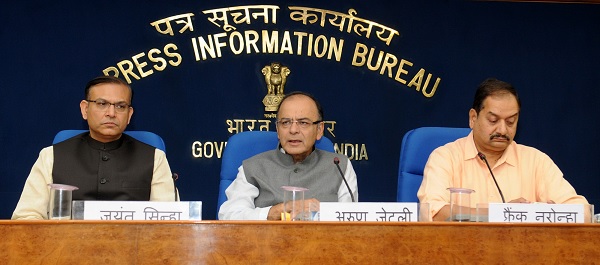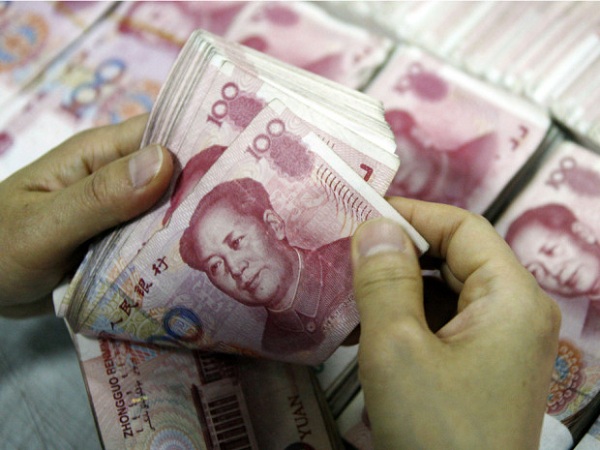
by Editor | May 25, 2021 | Corporate, Corporate finance
 New Delhi:(IANS) India’s aluminium industry on Sunday called on the government to raise duties on import of the metal to stem the flow of cheap imports from China.
New Delhi:(IANS) India’s aluminium industry on Sunday called on the government to raise duties on import of the metal to stem the flow of cheap imports from China.
An Aluminium Association of India delegation, led by Vedanta Group chief executive Tom Albanese, Hindalco deputy managing director D.Satish Pai and Nalco chairman T.K.Chand, met Finance Minister Arun Jaitley here to impress upon him the need to hike duties to prevent imports from impacting industry investments of over Rs.100,000 crore.
“We are here to present aluminium industry’s case and the difficulty we are facing. Finance minister gave us a patient hearing. He is aware of our situation and we are quite sure that he will take the right decision,” Pai told reporters here after the meeting.
Imports accounted for 56 percent of aluminium consumption in 2014-15, having grown by over 159 percent to 1,563 kilo tonnes (KT) in 2015, compared to 881 KT in 2011, mainly from China and Middle Eastern countries.
China accounts for more than 50 percent of world aluminium production, while their exports to India have surged by 200 percent in the last fiscal as compared to in 2010-11.
An official source told IANS after the meeting that the government has asked the industry to provide performance figures of various companies for it to study whether a hike in import duty is necessary.
Commerce Minister Nirmala Sitharaman last month told parliament that the government was considering a request for doubling the duty on aluminium imports to 10 percent, following representations that import of aluminium scrap and the metal’s decreasing global prices are adversely impacting the industry in India.
India’s aluminium demand has been growing at an annual rate of about 11 percent, compared to a global growth of 6 percent. Imports rose 4 percent to 390,000 tonnes in the first quarter of this fiscal ending June, compared to that in the same period a year ago.
Last month, the Anil Agarwal-led Vedanta subsidiary Balco, said it had shut down its aluminium rolling business owing to a steep fall in the prices, besides dumping of the metal by China, and falling margins.
Vedanta Aluminium also said last month that it has started the process of cutting down its Lanjigarh facility’s production by 50 percent that would impact up to 2,000 jobs.

by Editor | May 25, 2021 | Muslim World
 Beijing:(IANS) China is willing to have comprehensive cooperation with Arab states on the internet and build an “online Silk road” to benefit people in these countries, the media reported on Friday.
Beijing:(IANS) China is willing to have comprehensive cooperation with Arab states on the internet and build an “online Silk road” to benefit people in these countries, the media reported on Friday.
The announcement was made by Lu Wei, director of the Cyberspace Administration of China (CAC), in the China-Arab States Expo Online Silk Road Forum on Thursday.
The forum was held in Yinchuan, the capital of Ningxia Hui region with over 800 politicians, business representatives and scholars from over 10 Arab countries and other nations including the India, Germany and the US in attendance.
It was the first time the Online Silk Road Forum was being held in Yinchuan. The forum was a part of the ongoing China-Arab States Expo 2015, which kicked off on Thursday morning.
In the forum, Lu vowed to promote cooperation with Arab countries to speed up the construction of regional cyber facilities, optimise the allocation of internet infrastructure and accelerate the popularity of 4G network and public Wi-Fi, in a bid to allow more people in poor areas to access the Internet and obtain information and knowledge.
He also proposed to deepen cooperation with Arab countries in digital economy including establishing a common market online and boosting development in the fields of commerce, trade, logistics and tourism by joining hands in customs clearance, inspection, quarantine and financial payment.
According to Lu, the e-commerce trade volume in 2014 exceeded 13 trillion yuan ($2 trillion) and is expected to reach 18 trillion yuan in 2015. There are more than 330 listed internet companies with a total market value of 3 trillion yuan.
Cooperation in new technologies involving cloud computing, big data and cultural exchanges will also be carried out to enhance connectivity to the internet which is a key to the Belt and Road Initiative and building a community of shared destiny with Arab countries.
“As Chinese President Xi Jinping has said, no matter if it is a highway, railway, an airline or the Internet, our cooperation reaches where there is a way. As the online Silk Road has set its sail, China and Arab states can utilize the online road to link the two great civilisations and make new contributions to the advancement of human beings,” Lu said.
Since China’s Belt and Road Initiative strategy, which refers to the Silk Road economic belt and the 21st century maritime Silk Road, was initiated at the end of 2013, significant progress has been made and increasing support has been garnered from the international community.

by Editor | May 25, 2021 | Economy, News, World
 Dubai:(IANS) Diplomats and business executives from BRICS countries — Brazil, Russia, India, China and South Africa — agreed on Wednesday that the emerging markets can retain growth momentum by developing their economies and expanding trade ties.
Dubai:(IANS) Diplomats and business executives from BRICS countries — Brazil, Russia, India, China and South Africa — agreed on Wednesday that the emerging markets can retain growth momentum by developing their economies and expanding trade ties.
Speaking at the first BRICS forum held in Dubai, He Zhanghua, China’s Ambassador to the United Arab Emirates (UAE), said BRICS countries were all big influential powers with distinctive shining points, potentials for future development and unique advantages in conducting cooperation, Xinhua reported.
“Just as Chinese President Xi Jinping pointed out at the Ufa Summit, BRICS countries are like the five fingers of a hand,” he said.
BRICS members make up 40 percent of the world population.
The ambassador said China is making efforts with other countries in the world, including the UAE and other BRICS countries, to push forward the Silk Road Economic Belt and 21st Maritime Silk Road.
At present, the trade volume between BRICS countries and the UAE accounts for one fourth of the UAE’s total trade.
Igor Egorov, chairman of the Russian Business Council, said the atmosphere of the forum is very promising. “All sides seemed to be open for cooperation, ready for progress and willing to achieve it, ” Egorov said.
Ahmed bin Sulayem, executive chairman of Dubai Multi-Commodities Center (DMCC), said companies from BRICS members were the driving force of the DMCC’s rise to be the biggest free zone in the UAE.
The DMCC harbors 11,000 firms from 170 nations and every month 200 new firms join, said bin Sulayem.
China’s oil giant Sinopec and Lukoil from the Russian Federation are among the licensed firms.

by Editor | May 25, 2021 | Corporate, Corporate Governance, Economy, News

Union Minister for Finance, Corporate Affairs and Information & Broadcasting, Arun Jaitley addressing a press conference, in New Delhi. The Minister of State for Finance, Jayant Sinha and the Director General (M&C), Press Information Bureau, A.P. Frank Noronha are also seen.
New Delhi:(IANS) Describing India as transiently impacted by recent events in China, Finance Minister Arun Jaitley on Tuesday said the global situation instead presented an opportunity for the country as it is a net importer of commodities and oil is in free fall.
“India is one of the lesser impacted economies (by China devaluation, slowdown), partly because our own fundamentals are reasonably strong,” Jaitley said while briefing reporters on Prime Minister Narendra Modi’s meeting here with union ministers, corporate heads and economists to discuss the global markets’ turmoil sparked off by the Chinese economic slowdown and attendant opportunities for India.
“The main thrust of the meeting was that since India is relatively touched little except for a transient impact on the markets, it should therefore strengthen its domestic economy so that the larger benefits of the global economy may come India’s way,” he said.
“Being a net importer of commodities globally, the low oil prices are an opportunity for us,” the finance minister added.
Global crude oil in free fall touched the $40-a-barrel mark in trading late in August, having already dropped under $50 for the second time this year from the level of over $100 last year.
The meeting, that lasted over three hours, discussed the global situation that impacted India economically like a possible hike in the US Federal Reserve rate, the world powers’ nuclear deal with Iran contributing partly to cheaper oil and the way the Chinese slowdown opens up opportunities.
A slowdown in the Chinese markets, which led to global markets’ crash, coupled with rupee volatility and the risk of a US rate hike, knocked out the Indian equity markets in August.
Reserve Bank Governor Raghuram Rajan, NITI Aayog Vice Chairman Arvind Panagariya, Chief Economic Advisor Arvind Subramanian and Aayog member Bibek Debroy also attended the meeting on ‘Recent Global Events: Opportunities for India’.
Apart from heads of industry chambers, top industrialists such as Reliance Industries’ Mukesh Ambani, Aditya Birla Group head Kumar Mangalam Birla, Adani group chairman Gautam Adani, Tata group chief Cyrus Mistry, Wipro chief Azim Premji, Sun Pharma CMD Dilip Sanghvi, ITC’s Y.C. Deveshwar and Infrastructure Leasing and Financial Services Limited chairman Ravi Parthasarathy were among those who attended.
“The general consensus was that growth of emerging economies is all slowing down, except that we (India) are growing at seven percent. So how can we take advantage of this opportunity (of slowdown elsewhere),” Confederation of Indian Industry president Sumit Mazumdar told reporters after the meeting.
“The prime minister said this is an opportunity for us to take advantage of and invest. Cost of capital is too high but I don’t know how many people can go ahead to take risk and invest… many of us raised the issue of interest rate,” said Federation of Indian Chambers of Commerce and Industry (Ficci) president Jyotsna Suri.

by Editor | May 25, 2021 | World

Photo Credit: FinancialExpress
Mumbai:(IANS) Negative cues eminating out of China coupled with bearish equity markets resulted in the rupee falling to its lowest levels against the US dollar in over two years during the intra-day trade on Monday.
The Indian currency was trading at 66.83 to a dollar at 4.00 p.m., down 37 paise from its previous close of 66.46 on Friday (September 4, 2015). The rupee had touched an intra-day high of 66.85.
The rupee had last breached the 66.80-level to a greenback on September 4, 2013.
The Indian currency came in for a beating as frantic dollar-buying in China devalued the off-shore yuan and other Asian currencies, including the rupee.
The volatility started after reports from China suggested that the central bank there was planning to impose stringent regulations on foreign exchange purchases from October to curb speculation and volatility.
Interestingly, the Chinese yuan was two percent weaker in off-shore markets than domestically.
“The rupee is being impacted from the pressure put on yuan (devaluation) and the expected shortfall of dollars in China due to the reports on new regulations,” Anindya Banerjee, associate vice president for currency derivatives with Kotak Securities explained to IANS.
“The macro data on foreign reserves from China suggest there has been a huge outflow of funds despite direct investments and exports.”
The rupee’s downward spiral also impacted the barometer index of the Indian equity markets the 30-scrip sensitive index (Sensex) of the Bombay Stock Exchange (BSE) which plunged by over 308 points or 1.22 percent at close of trading on Monday.
Investor confidence was eroded on the back of fears of an interest rate hike in the US, weak monsoon and bearish Asian markets.

 New Delhi:(IANS) India’s aluminium industry on Sunday called on the government to raise duties on import of the metal to stem the flow of cheap imports from China.
New Delhi:(IANS) India’s aluminium industry on Sunday called on the government to raise duties on import of the metal to stem the flow of cheap imports from China.



